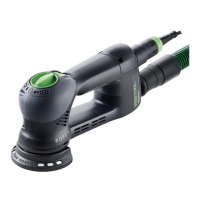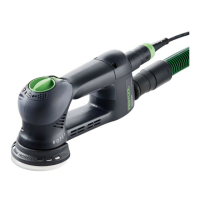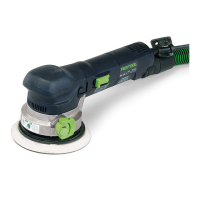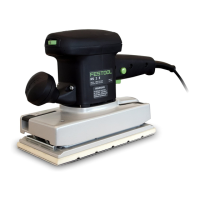10 Rotex Series Dual Mode Sanders
Setup
Changing Sanding Pads
Each model sander may be used with a variety of sanding
pad options. It may also be necessary to change sanding
pads for different sanding purposes or when they become
worn.
CAUTION! Do not use a sanding pad if it no longer
holds the sanding disk in place. Using a worn pad
can result in the sanding disk to y off the pad and
cause injury. Sanding pads are considered a wear
item and should be replaced when the StickFix
hook-&-loop bers cannot rmly hold the sanding
disk.
NOTE: Excessive heat from sanding will cause the
sanding pads to wear faster. To maximize your pad
life, avoid operations that generate excessive friction
and heat, such as sanding stationary on a sharp edge
or applying too much pressure while sanding.
Choosing the Correct Sanding Pad
Sanding pads come in different grades of hardness/soft-
ness for improved performance for different sanding tasks.
The hardness or softness of the sanding pad determines
how much the sanding pad conforms to the surface being
sanded.
A harder sanding pad is best for course sanding on at sur-
faces. The rmer pad resists creating a wavy surface where
there are softer and harder portions of the wood ber. This
is especially important with woods that have a wide spacing
in their annular growth rings or signicant differences in the
density of the wood ber between rings.
A slightly softer sanding pad is best used for progressively
ner sanding of the workpiece. This permits the pad to
slightly conform to the surface to ensure previous grit sand-
ing marks are removed, but is less prone to creating a wavy
surface because the grit is less aggressive.
Similarly, a very soft sanding pad is best used for ne
sanding or sanding of nishes. Having greater conformance
to the very small waves in the surface is desired, and with
the high grit abrasive, risk of creating deeper waves is less
likely.
Blue / Hard
Black / Soft Gray / Super Soft
Removing/Installing the Pad
1. Unplug the sander for safety.
2. Lock the sander spindle from rotating:
► For the RO90, turn the mode selector to the DX (orbital)
mode.
► For the RO125 and RO150, slide the mode selector to
the Rotex mode, and press in on the spindle lock button.
3. Rotate the pad 1/4-turn to remove or install it.
RO-90 DX Mode
DX Mode
RO-125
Spindle
Lock
RO-150
Spindle
Lock
Tighten
Loosen

